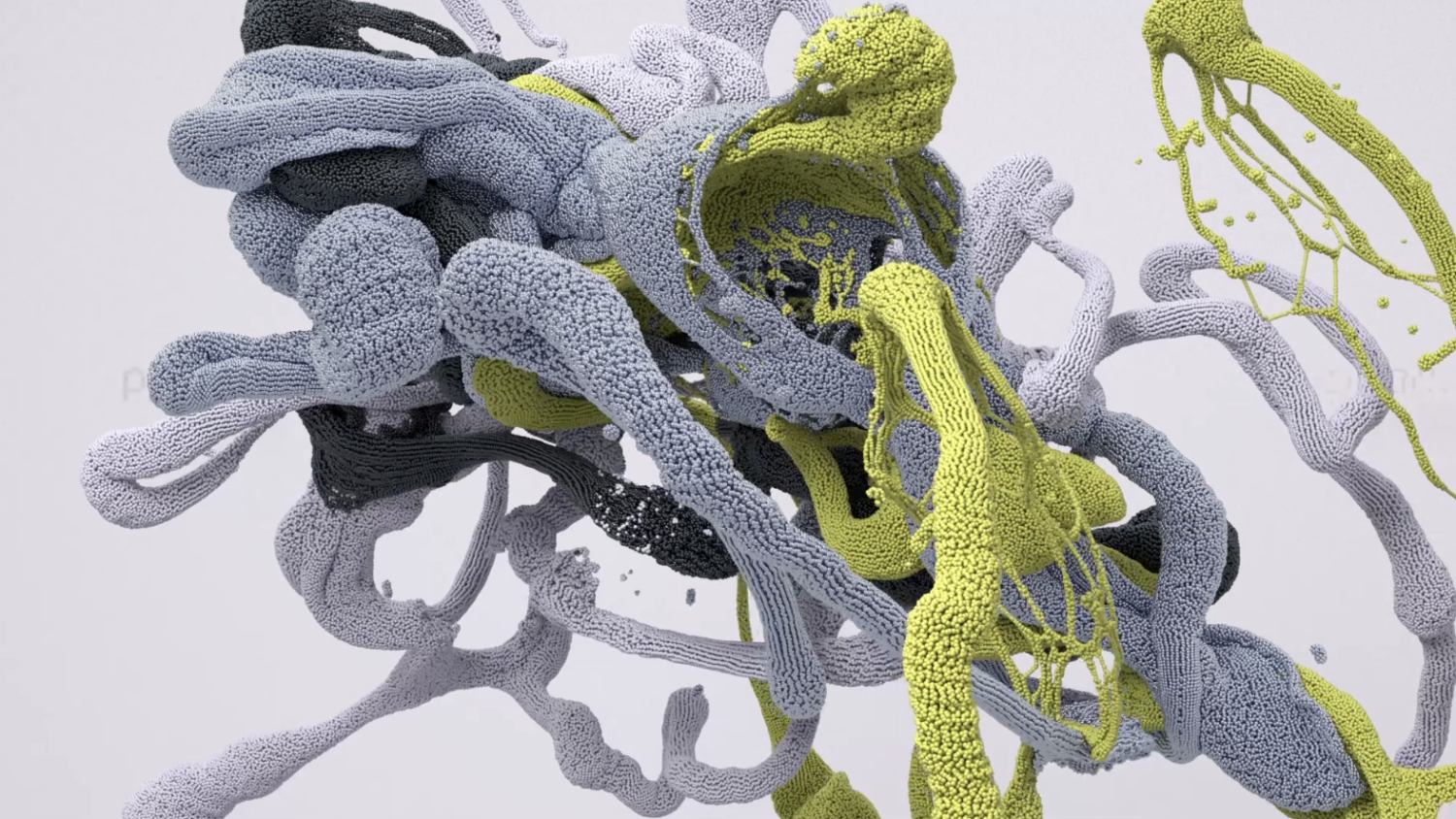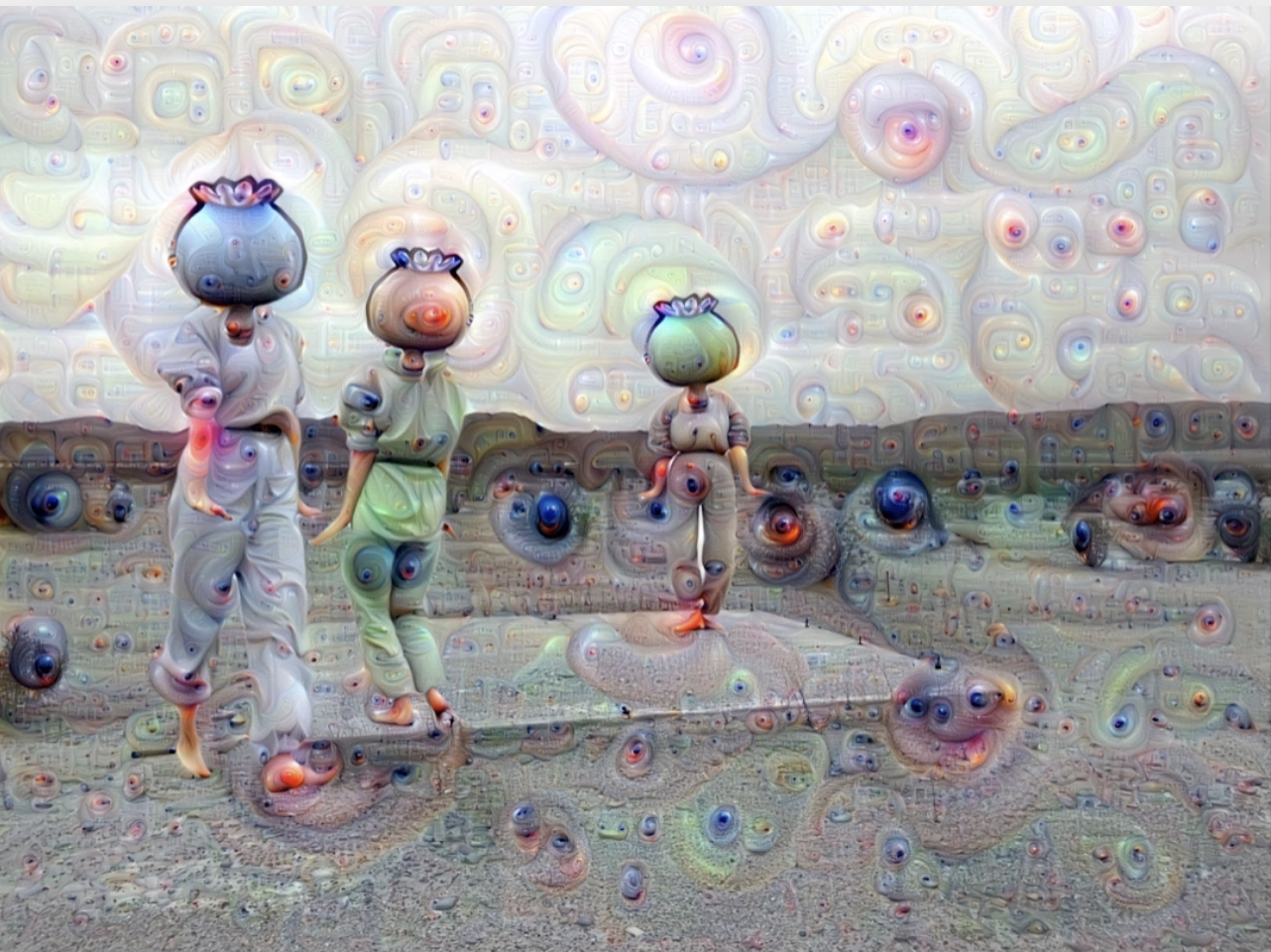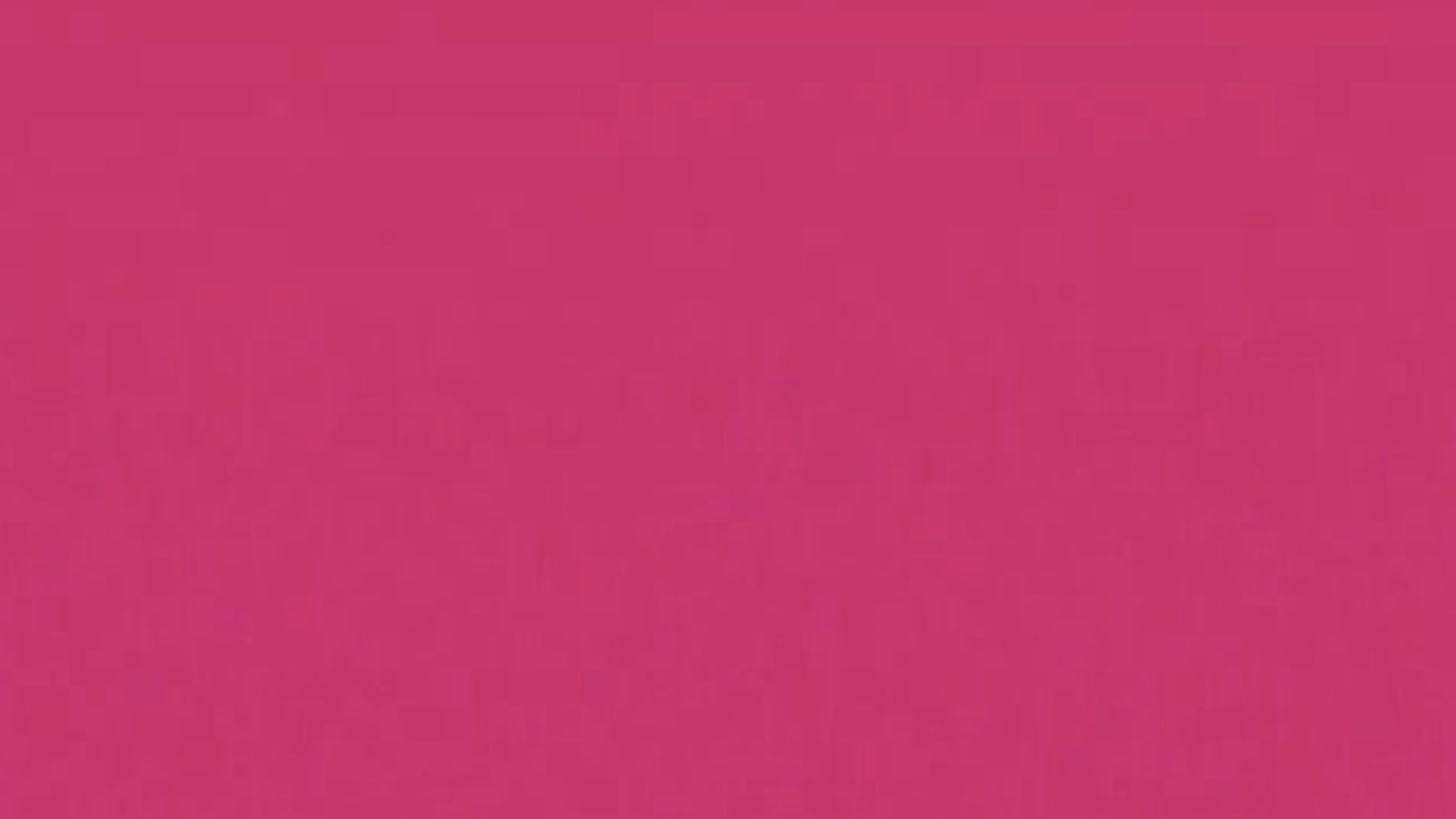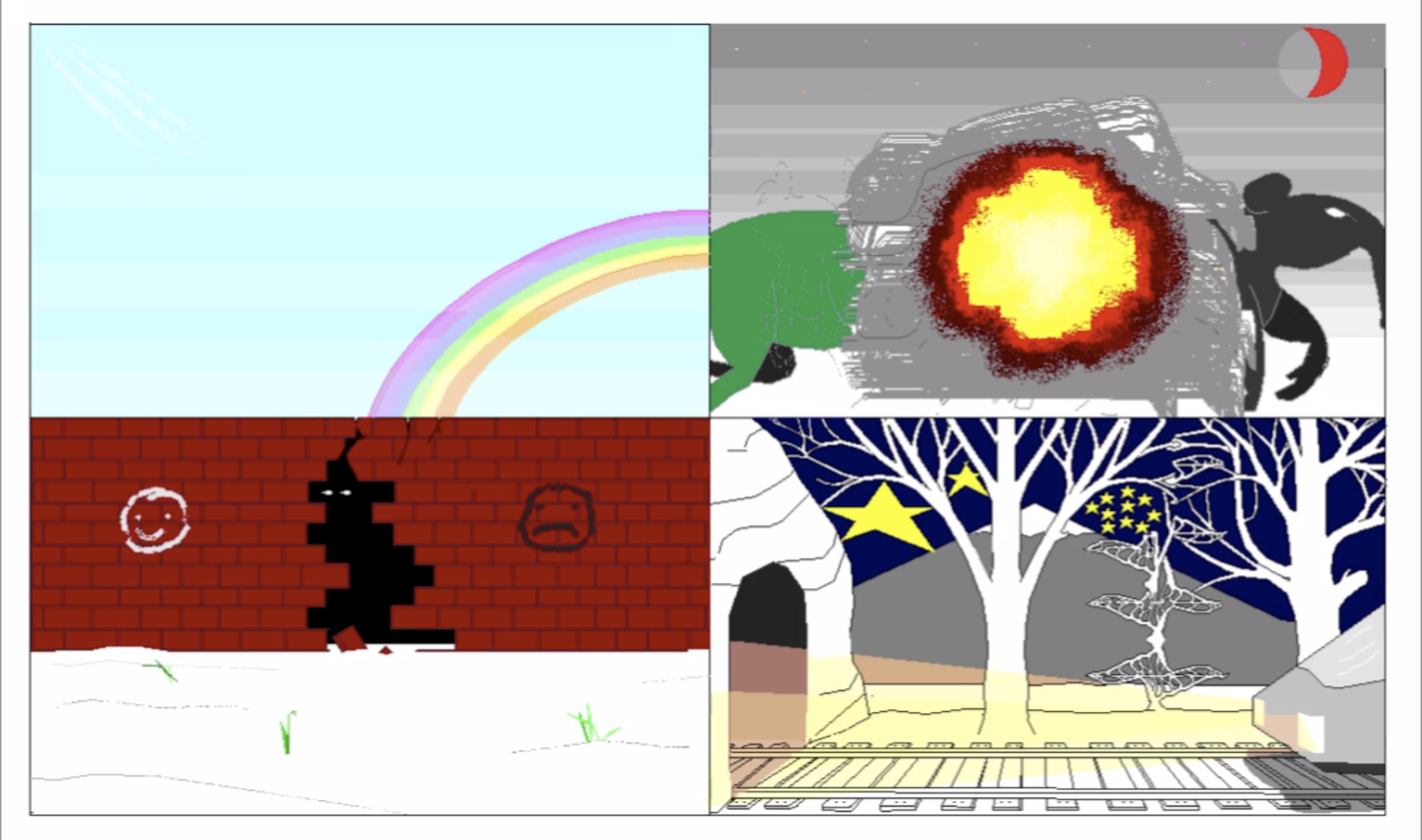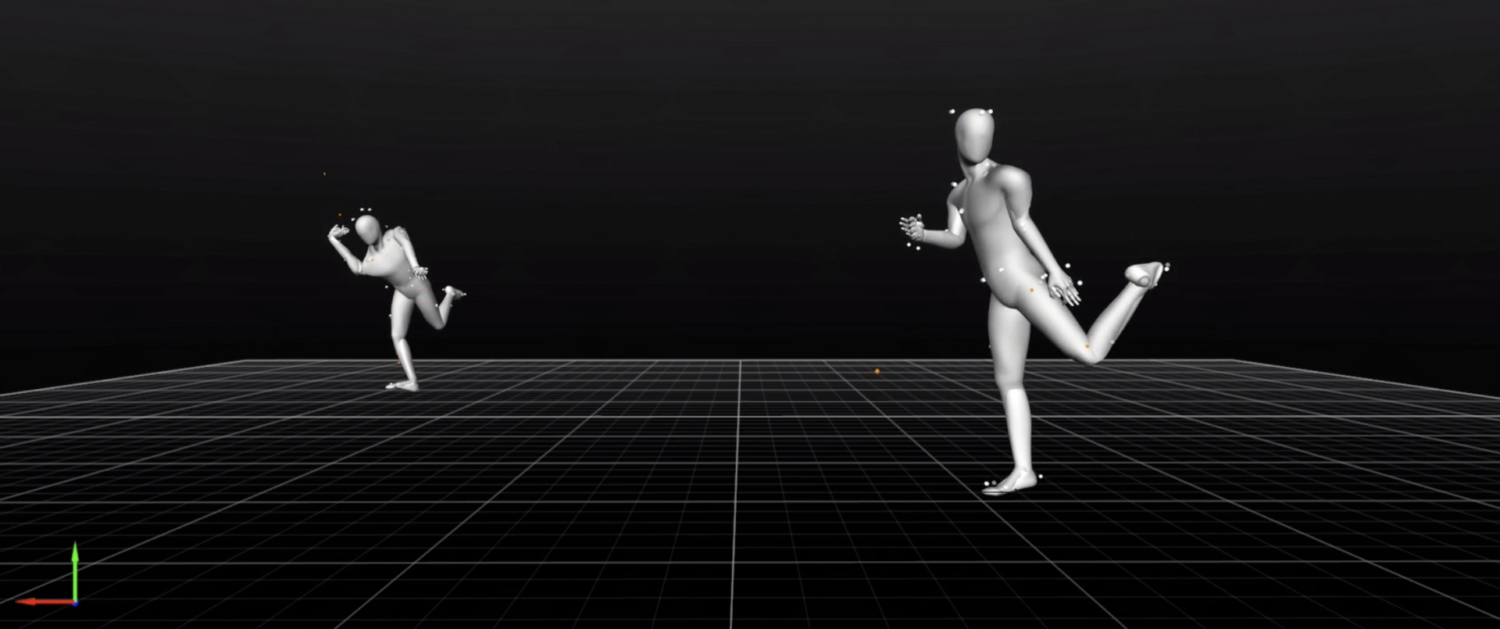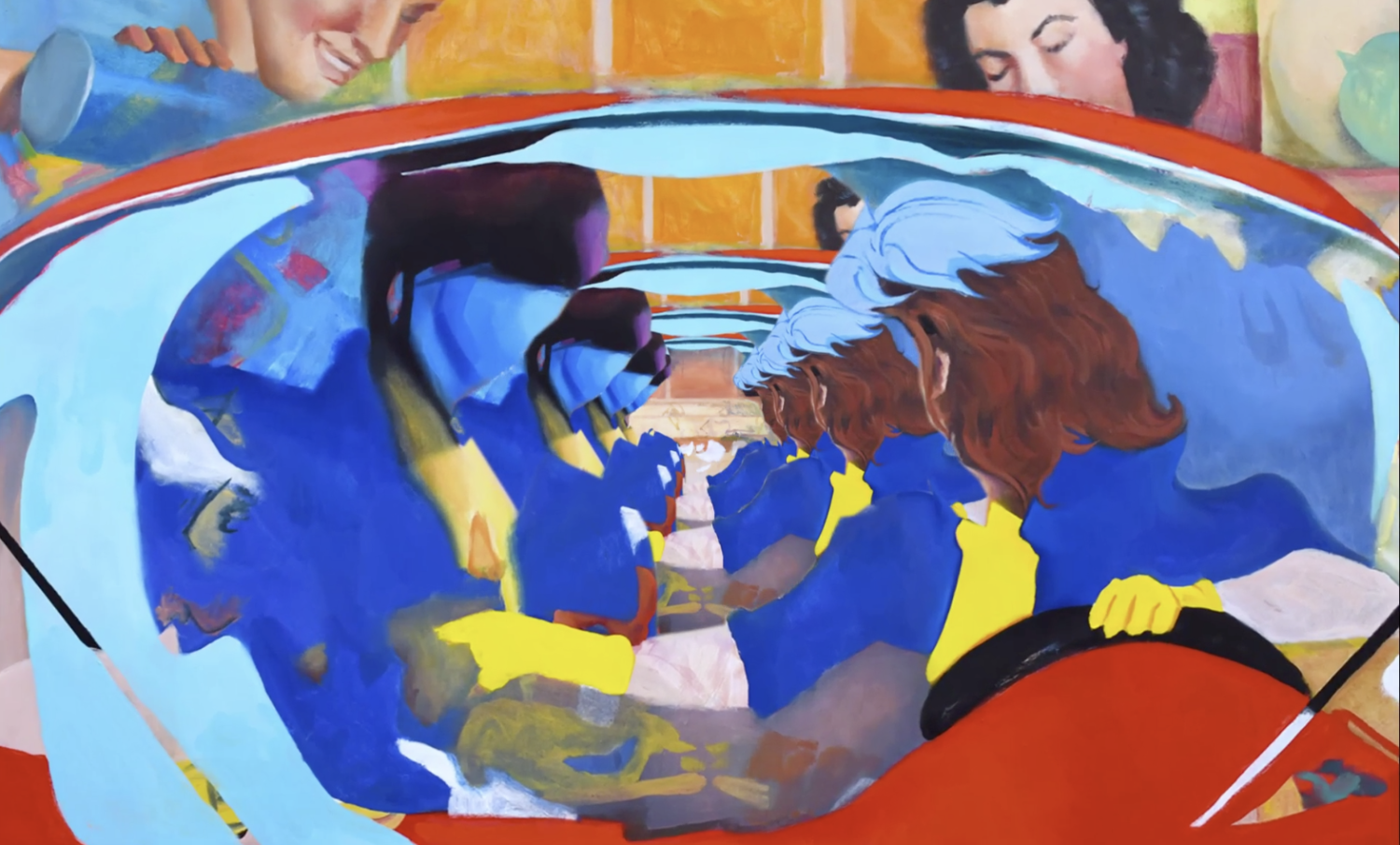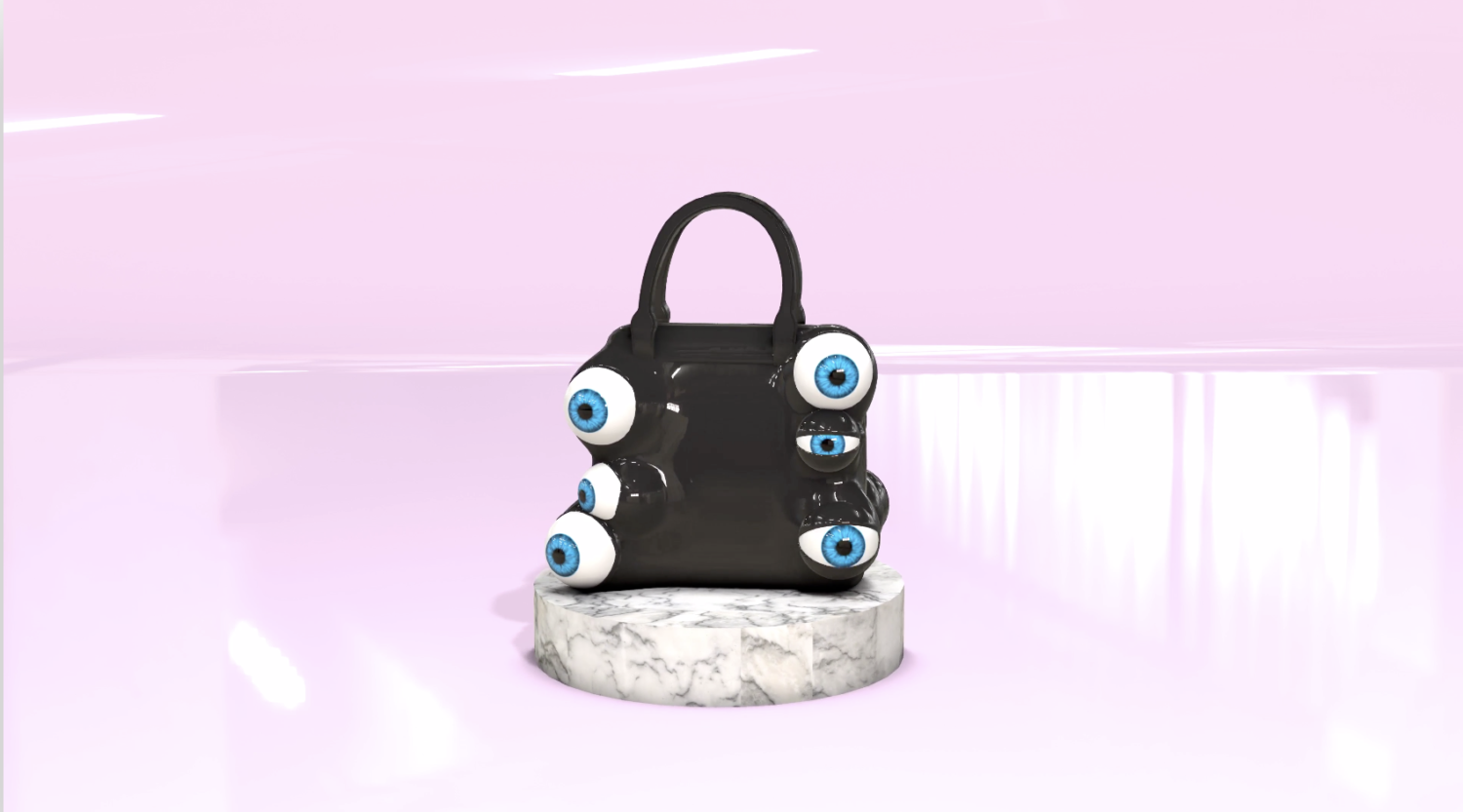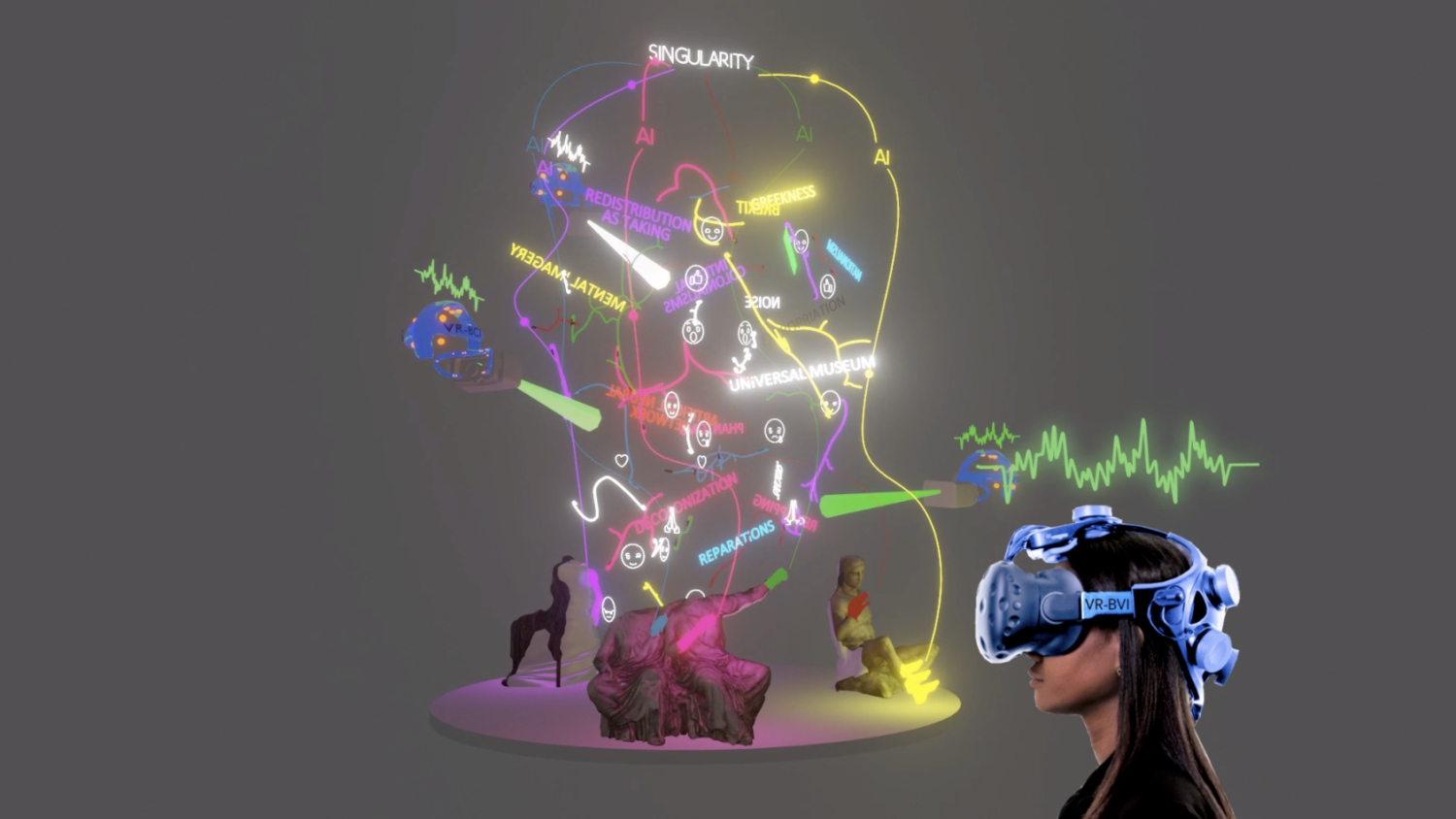PRISKA PASQUER VIRTUAL GALLERY
WINDS OF CHANGE
NFT ART SHOW
CURATED BY PRISKA PASQUER & CHRISTIANE MARIA SCHNEIDER
Link to enter VIRTUAL GALLERY
https://hubs.mozilla.com/2ZBNWda/PRISKA_PASQUER_VIRTUAL_GALLERY/
PRESS
Artmagazine, Mobiler, jünger, bunter, weiblicher, July 12, 2021
Handelsblatt, Der Geist ist aus der Flasche, Juli, 2021
PRISKA PASQUER exhibits NFT Art for the first time
WINDS OF CHANGE is the beginning of a new exhibition series of PRISKA PASQUER dedicated to crypto-based art. The original digital artworks will be presented in a virtual “Offshore-Show”. For over 20 years, PRISKA PASQUER Gallery has collaborated with artists who engage with current questions and new forms of artistic engagement through a variety of media. The gallery’s first exhibition exclusively featuring NFTs (non-fungible tokens) provides an overview, as well as a broad spectrum of different approaches.
With the NFTs, a new, purely digital practice has emerged. The artworks are being viewed on computer screens, discussed in the digital space of Clubhouse, traded on digital platforms and paid with crypto currency. Consequently, PRISKA PASQUER will present her first NFT exhibition in the virtual gallery space, which allows a dialog and an interaction between the visitors. This “Offshore-Show” presents NFT artworks on screens supported by pillars, in the sea. Indirectly, they even generate electricity like the wind turbines of which they are reminiscent, because the gallery will donate ten percent of the sales proceeds from this exhibition directly to green electricity providers.
The virtual gallery opened in February 2021 with the four-part project “ONE TO ONE – One Curator Meets One Artist” which was developed in cooperation with the curatorial collective peer to space. Set on an island in the sea, a replica of the upper floor of PRISKA PASQUER’s gallery space in Cologne’s was created.The virtual gallery is a presentation and communication space in which it is possible to share art experiences, as well as engaged encounters despite the Corona crisis. Anyone can visit the gallery as an avatar and talk and exchange ideas with other visitors. PRISKA PASQUER sees her work with artworks in virtual space as an extension of her gallery activities. The basis is the analog space as a place for the physical encounter between artwork and viewer.
For many years, the PRISKA PASQUER Gallery has been addressing profound changes in the digital age through cross-media exhibitions and has been consistently pursuing the possibilities of digitalization. As early as 2013, PRISKA PASQUER set up a webshop, operates a Youtube channel, and is active on Instagram, tumblr, Facebook, and other relevant platforms such as Artsy, Artnet, Iazzu, and Artland. Artworks available as NFTs by the gallery’s artists are offered on platforms like “Foundation”.
ARTISTS
ELENA BAJO
Born in Madrid in 1976; lives and works in Los Angeles and Berlin
ELENA BAJO initially studied pharmacy before switching to art. After studying architecture in Barcelona, she obtained a Master of Fine Arts degree at the Central Saint Martins School of Art in London in 2005. Since 2008, her works have been featured in numerous international individual and group exhibitions, including in the São Paulo Museum of Art, Jan Van Eyck Academie (Maastricht), FRAC Normandie (Rouen), Kai 10 Arthena Foundation (Düsseldorf) and 3rd Mardin Biennial (Mardin). In 2012, ELENA BAJO was the Artist in Residence in the BANFF Center, Alberta (CA), and at Platform3 in Munich. This was followed in 2014 by a residence in the Lab 18th St Arts Center in Los Angeles. ELENA BAJO explores themes such as space, politics, feminism and environmental awareness. The frame of reference used in her installations, sculptures and performances is generally composed of texts or other sources of knowledge. Besides anarchistic and feminist writings, she references alternative forms of knowledge and practices, shamanistic traditions or paradigms of environmental activism.
Elena Bajo, Dance of the Opium Poppies, 2021
The artwork Dance of the Opium Poppies is part of the project A Growing Wave Breaks in the Shore of Time (Tomorrow I was a Plant), part of a bigger body of work that is called the Cosmic Distress Series, that investigates psychoactive plant systems as narrators of their own ecological consciousness from an Eco-Psycho-active feminist perspective. In this project, the human brain becomes a plant brain, human becoming plant, plants being channeled by humans, the materialization of the Psychoactive effects visible and discursive.
https://foundation.app/@priskaxartist/priska-x-elena-bajo-dance-of-opium-poppies-2021-49871
BANZ & BOWINKEL
Giulia Bowinkel (born in Düsseldorf in 1983) and Friedemann Banz (born in Mainz in 1980); live and work in Berlin
FRIEDEMANN BANZ and GIULIA BOWINKEL studied at Düsseldorf Art Academy. Since 2016, their work has been shown in numerous individual and group exhibitions including in Museum Abteiberg in Mönchengladbach, Haus der elektronischen Künste in Basel, Halle für Kunst & Medien in Graz, Zeppelin Museum in Friedrichshafen and Haus Esters/Haus Lange in Krefeld. BANZ & BOWINKEL explore the blurred lines between real and virtual space. Their work is based on the notion that the virtual world is not the domain of simulated reality but rather its counterpart, in which computers – as an unconscious force – subject the meaning of our society to a new order. For BANZ & BOWINKEL, we already live in a semi-virtual environment in which almost everything is pre-calculated and carried out by computers. The artist duo uses computers resolutely as both tools and as an interactive interface where artworks can be created and presented.
Banz & Bowinkel, Current III 01, 2021
BANZ & BOWINKEL’s work shines a spotlight on computers as an everyday medium and on the influence they have on us. In doing so, they play with our altered perception in a world the reality of which has been simulated using computers. For the video work Current III 01 (2021, CG HD video loop), the artists’ movements were recorded, digitally reconstructed and coupled with virtual avatars who use these movements to control fluid simulations. This gives rise to abstract compositions that call into question the reproducibility of digital artefacts.
JANE BENSON
Born in Thornbury, England, in 1972; lives and works in London and New York
JANE BENSON studied painting at Edinburgh College of Art (receiving a BA (Hons) and obtained her Master of Fine Art degree at the School of the Art Institute of Chicago. Since 1993, her works have been shown in numerous individual and group exhibitions, including in Abrons Art Center, New York; Kunsthalle Emden; Queens Museum, Queens, New York; P.S.1 Contemporary Art Center/Museum of Modern Art, New York. In 2017, the Contemporary Arts Center (Cincinnati, OH) presented the large-scale individual exhibition Jane Benson. Half-Truths. JANE BENSON’s works explore the transition and transformation of physical materials and aesthetic identity and those of socio-political circumstances or individual biographies. Her works seek to re-place, re-map and re-engage accepted cultural standards, classical forms of categorisation and archetypal structures.
Jane Benson, Everyday to Come, 2021
Benson documents the shadow play of one of the artists iconic unabashedly fake plants; artificial trees altered to look artificial, each leaf cut into an unnatural shape, such as square, to create unabashedly fake trees and a fantasy of future genetic mutations. The haunting image is accompanied by a soundtrack composed by excavating a score from within The System of Nature (1770) by Holbach a haunting philosophical work that highlights humankind’s alienation from nature and that profoundly resonates in today’s world.
https://foundation.app/@priskaxartist/priska-x-jane-benson-everyday-to-come-2021-49861
RUDOLF BONVIE
Born in 1947; lives and works in Cologne
RUDOLF BONVIE studied at the Kölner Werkschulen art academies and at the Philosophy Faculty of Cologne University. In addition to many individual exhibitions including in Museum Folkwang (Essen,1988), Lenbachhaus (Munich, 1991) and Kunstverein Karlsruhe (Karlsruhe,1990), RUDOLF BONVIE has been involved in a number of significant group exhibitions. These include Die Reste des Authentischen at Museum Folkwang, Essen (1986), Blow Up at Kunstverein Stuttgart (1987), Fotografie in derdeutschen Gegenwartskunst at Museum Ludwig, Cologne (1993), and Deutschlandbilder at Martin-Gropius-Bau, Berlin (1997). BONVIE’s works can be found in the Museum of Modern Art (New York), Museum of Fine Arts (Houston), Museum Folkwang, (Essen), Lenbachhaus (Munich), ZKM (Karlsruhe), Museum Ludwig (Cologne) and in the Staatsgalerie (Stuttgart) as well as in numerous German and US private collections. RUDOLF BONVIE is regarded as one of Germany’s first media artists, one whose work explores the function and impact of communication with images. In his multifarious body of work, he combines social questions with aspects of photographic theory. The artist’s critical observations revolve mainly around three thematic issues: the growing narcissism in our society, the exuberant flood of images and the looming threat of nuclear disaster.
Rudolf Bonvie, Tumblrwork 5, 2013
In his Tumblr works, RUDOLF BONVIE xplores perceptions of his own artistic works on the internet. He uploads these to the Tumblr blog portal where they are “shared” by other users. In this way, the works become part of other people’s visual worlds. These ever-changing contexts of his works have been compressed and fixed by the artist in his Tumblr works. He explores the impact of communication with images and combines social questions with aspects of photographic theory.
https://foundation.app/@priskaxartist/priska-x-rudolf-bonvie-tumblrwork-5-2013-49849
ORNELLA FIERES
Born in Frankfurt in 1984; lives an works in Berlin
ORNELLA FIERES studied at Macquarie University in Sydney and at the HfG Offenbach, where she is currently working on her PhD in media studies. Her resume includes international exhibitions at the School of the Art Institute of Chicago, the Goethe Institut Toronto, the Literaturhaus Berlin and galleries in New York and Berlin.
Ornella Fieres, disintegration attempt, 2021
ORNELLA FIERES works with analog imagery from the turn of the 20th century – a time that was coined by a fascination of occultism in combination with technology – and processes the found footage with seemingly alchemistic methods using self-built apparatuses, tweaked algorithms, or artificial intelligence. Her NFT piece disintegration attempt (2021, NFT including sound) visualizes the concept of digital information not being able to disappear: every digitized moment (or its dissembled data) is bound to exist eternally in the endless digital realm.
https://foundation.app/@priskaxartist/priska-x-ornella-fieres-disintegration-attempt-49701
ZOHAR FRAIMAN
Born in Jerusalem, Israel in 1987; lives and works in Berlin
ZOHAR FRAIMAN studied at the Jerusalem Studio School, Israel (2005-09) and graduated as a master student from the Universität der Künste, Berlin (2011-15). FRAIMAN regularly exhibits internationally in group and solo shows, including Han Pin Art Museum, Hangzhou, China (2015), Museion Atelierhaus Bolzano, IT (2016), Kunsthalle Lüneburg, D (2017), Schloss Achberg, D (2017), Turps Gallery London, UK (2018), Museum der bildenden Künste Leipzig, D (2019), and Petach Tikva Museum of Art, IL (2019). She is a member of the Saloon network for women in the Berlin art scene.
Zohar Fraiman, Porsche Divorce, 2021
ZOHAR FRAIMAN uses humour to raise socially critical questions and to constantly urge us to question what we are being shown. In doing so, she repeatedly casts an critical eye on the complex realities of everyday life and, as in the Porsche Divorce NFT, transforms the image of the traditional 1950s nuclear family into the modern age. Through the use of contrasting elements, she portrays social expectations and perceptions of apparent ideals that are being applied to forms of female identity.
https://foundation.app/@priskaxartist/priska-x-zohar-fraiman-porsche-divorce-2021-49839
GOODLIFE
Goodlife, Punk, 2021
A historical moment: the leaders of the digital world are meeting on clubhouse for to celebrate Christie’s live auction. The NFT-based CryptoPunks from Larva Labs are included in this New York evening sale as well as a 1983 skull painting by Jean-Michel Basquiat. A leading art adviser speaks about the importance of Basquiat. The media artist Goodlife created a collage of this important moment on clubhouse. An encounter of merging worlds: the digital world and the art world.
https://foundation.app/@priskaxartist/priska-x-goodlife-punk-2021-collage-37045
RADENKO MILAK
Born in Travnik, Bosnia and Herzegovina, in 1980; lives in Banja Luka, Bosnia and Herzegovina
RADENKO MILAK studied at the Art Academy in Banja Luka and at the University of Arts in Belgrade, Serbia. In 2014, the Kunsthalle Darmstadt exhibition hall held the first major individual exhibition of his works in Germany; in 2016, his works were displayed at the Bosnia and Herzegovina pavilion at the Venice Biennale. In his paintings and animated films – mostly watercolours with black pigment – RADENKO MILAK analyses the role of contemporary image production in the formation of our historical and cultural memory. The Bosnian artist’s painting centres on questions relating to how visual elements are fixed and stored – both in personal memories and as presented in the media of film and photography. For his first major work 365 – Image of Time(2014), RADENKO MILAK painted 365 watercolours depicting events of the 20th century. Each page references a “planetary event” (Radenko Milak). The subject matter varies widely, including war and peace, art and culture, science and technology, space travel and natural disasters. Europe, the Americas, Africa, Asia – and, time and time again, the Balkans – make up the spatial framework for this historical calendar of the last 500 years.
Radenko Milak, Universe, 2021
The animation Universe was created as part of the Anthropocene group of works – an artistic exploration of the new era, one in which humans have become one of the most important influences on the Earth’s biological, geological and atmospheric processes. These also include motifs that are only visible through a nano microscope and images of the universe supplied by the Hubble Space Telescope – all of which are given an additional layer of mystery by MILAK’s watercolour brush and use of black pigment.
https://foundation.app/@priskaxartist/priska-x-radenko-milak-universe-2021-49855
WARREN NEIDICH
Born in New York in 1958; lives and works in Berlin and Los Angeles
WARREN NEIDICH studied photography, video and cognitive neurosciences, medicine and architecture. He taught at Berlin Weissensee School of Art and was a visiting academic at the Otis College of Art and Design in Los Angeles. NEIDICH is the founding director of the Saas-Fee Summer Institute of Art. He explores topical questions, such as in his work Pizzagate (2017). The large, three-dimensional neon sculpture has the form of an iCloud, which is set up diagrammatically as a network. In this work, which was also shown as part of Venice Biennale 2019, NEIDICH examines the effects of Fake News.
Warren Neidich, Brain without Organs 1, 2021
As an author, art theoretician and interdisciplinary post-conceptual artist, WARREN NEIDICH examines how digital possibilities change our habits, perceptions and ideas. His exploratory work focuses on the neuroaesthetics field of artistic research, in which sensory impressions, perception and consciousness are examined with the aid of techniques, methods, devices, critiques and the history of artistic production.
https://foundation.app/@priskaxartist/priskax-warren-neidich-brain-without-organs1-2021-35867
HANNO OTTEN
Born in Cologne in 1954; lives and works in Cologne
After graduating in ceramics from the Höhr-Grenzhausen School of Design, HANNO OTTEN studied art at the Gesamthochschule Kassel under Harry Kramer (sculpture), Floris M. Neusüss (photography) and Tom Gramse (drawing). He received the Friedrich Vordemberge Stipend of the City of Cologne for Fine Art in 1988 and was guest artist of the Villa Romana, Florence, in 2001. HANNO OTTEN’s work has been widely exhibited, mainly in Germany and the USA. HANNO OTTEN is renowned above all for his work with colour. Years spent plumbing the depths of a single topic have given rise to sizeable groups of works such as Colourblocks, Schlachtenbilder (Battle Pictures) and Über Malerei (About Painting). At the start of the 1990s, HANNO OTTEN started to explore the connection between colour and light. HANNO OTTEN’s work has been widely exhibited, mainly in Germany and the USA. HANNO OTTEN is renowned above all for his work with colour. Years spent plumbing the depths of a single topic have given rise to sizeable groups of works such as Colourblocks, Schlachtenbilder (Battle Pictures) and Über Malerei (About Painting). At the start of the 1990s, HANNO OTTEN started to explore the connection between colour and light.
Hanno Otten, Light 1, 2021
Working with a wide range of media, HANNO OTTEN examines questions relating to perception and visual thinking. One area he has explored is light and colour as a property of light. Produced without a camera, the abstractions are nothing but colour fixed on photo-sensitive paper. In 1998, Otten began applying this practice to the medium of film and experimenting with digital image generation. This is what led to the creation of Light 1 (2021), a sequence of colours in a changing rhythm.
https://foundation.app/@priskaxartist/priska-x-hanno-otten-light-1-2021-49867
CHARLIE STEIN
Born in 1986; lives and works in Berlin
She holds a postgraduate degree in fine art from the State Academy of Fine Art where she studied at the classes of Christian Jankowski and Rainer Ganahl in Stuttgart, as well as the class of Gerhard Merz in Munich. She was a recipient of a DAAD scholarship in 2010 to reside in Beijing, China. Recent exhibitions include Manifesta11, Villa Merkel, the Songjiang Art Museum in Shanghai, Museum Villa Rot and the 2017 edition of the Istanbul Biennial. In her work Charlie Stein deals with dominant cultural aesthetics questioning existing modes of perception within the context of a highly digitized, visually overstimulated world. Her material is gathered through extensive research and translated into drawings, installations, sculptures, paintings and text. Her focus lies on social structures, digital media and contemporary forms of communication.
Charlie Stein, Sentient Bag, 2021
Often working with fetish materials, beauty filter aesthetics and fragments from popular culture, STEIN’s work oscillates between consumer culture and sentient cybernetic object. In Sentient Bag (2021, Digital Video, 14 sec) the glossy surface entices the viewer, while a multitude of eyes gazes back at the audience.
https://foundation.app/@priskaxartist/priska-x-charlie-stein-sentient-bag-2021-44780
CHRISTIAN D. STEFANOVICI
Born in 1982 in Timișoara, Romania; lives and works in Cologne
CHRISTIAN D. STEFANOVICI studied painting at Alanus University in Bonn from 2006 bis 2010 with Prof. Gia Edzgveradze and from 2010 to 2013 at Kunstakademie Düsseldorf with Prof. Tal R. He holds a PhD (2018) from West University Timișoara, Romania. He was awarded with the Joseph- und Anna-Fassbender-Preis for Grafik und Buchkunst and in 2017 he received the bronze medal for painting at Arad Biennial in Arad, Romania. 2017-2018 STEFANOVICI was artist in residence im ESPRONCEDA – Center for Art & Culture, Barcelona, Spain.
Christian D. Stefanovici, Exodus 1, 2015
CHRISTIAN D. STEFANOVICI’s digital painting is inspired by the aesthetic of 1980s pixel art. He refers back to classic picture content and art history genres and to elements of more recent pop culture and memetic agitation. For the digital animation Exodus 21 (3.12.2015, MP4, video loop), STEFANOVICI used the reproduction of an antiquated image editing software from the early years of pixel-based image processing. The animated gif consists of four panels that explore different transitional periods and movements.
https://foundation.app/@priskaxartist/priska-x-christian-d-stefanovici-exodus-1-2015-49860
CHARLOTTE TRIEBUS
Born in 1988; lives and works in Cologne
CHARLOTTE TRIEBUS works as a performance artist and multidisciplinary art director. The main focus of her work is on examining the potential of interfaces between art, dance and technology. In 2018, she founded the New Human Body Society.
Charlotte Triebus, Virtually Physical 1, 2018
Her work Virtually Physical (2018) triggers the intertwining of the Virtual and the Physical, questioning the real and the imaginative. Two dancers’ movements are transformed into vector-based avatars using the motion tracking system Optitrack. The choreography of the two real dancers triggers glitches in the virtual system and tries to expose OptiTrack to its constants and to break them – to provoke improvisations and queer body movements from within the system.
https://foundation.app/@priskaxartist/priska-x-charlotte-triebus-virtually-physical-1-49847


